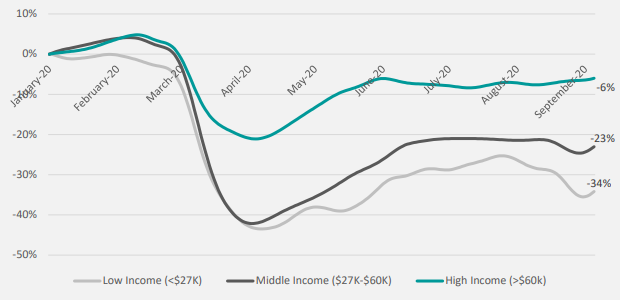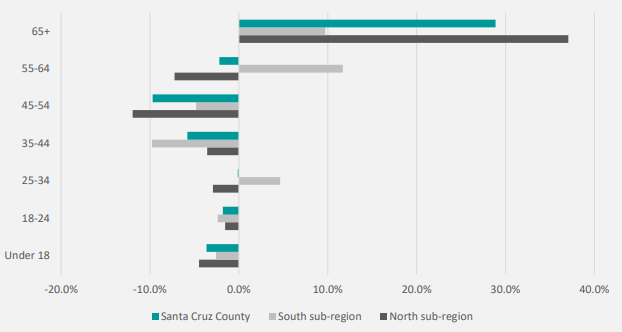Report shows worker shortage, aging population in Santa Cruz County
SANTA CRUZ COUNTY, Calif. (KION) Santa Cruz County has released its State of the Workforce report, and it shows just how much the COVID-19 affected the local economy.
While the county notes that there are some signs of economic recovery, the report shows that there have been disproportionate impacts for lower-income workers, a shortage of workers and a population that is growing older on average.
“California may have reopened for business, but the local labor force – particularly those who bore the brunt of the pandemic’s impacts – still has a long path of recovery ahead,” Workforce Development Board Director Andy Stone said. “COVID-19 has reshaped the way we work and do business in ways we are only now beginning to understand.”
The report includes nine findings and five recommendations. The findings include:
- A reorganization of the labor market may present challenges as the county works to rebound.
- A rise in remote work presents a challenge and opportunity for the county.
- Some of the most vulnerable workers were hit hardest by the pandemic.
- Many businesses, including small businesses, were hit particularly hard.
- The county saw lower unemployment, improvements in job quality and growth in higher-paying industries before the pandemic.
- Several industry clusters showed growth going into the pandemic and maintained resiliency through it.
- Industries that include tourism, hospitality and recreation may be the last jobs to return.
- Although the tech industry in the area is small, there are opportunities for IT workers in other industries.
- The population and workforce are getting older, especially in the northern part of the county.
It also included five recommendations, which are:
- Considering options to help employees return to work.
- Coordinate with others to expand existing industry clusters and help those that are developing.
- Work with local non-tech employers to make sure their IT needs are met.
- Encourage partnerships between schools and employers, especially in the southern part of the county.
- Support workers looking to switch to a new career.
KION has a closer look at some of the findings detailed in the report.
Reduction in Workforce
The County reports that there has been a shortage of workers who are willing and able to return to work, and that may partly be due to a drop in labor force participation.
The report shows that the drop in labor force participation is nearly twice as much as what it was during the Great Recession and four times higher than the current statewide decline in participation. In total, about 10,600 county residents appear to have left the workforce since February 2020, a 9% decline in labor force participation.
In April 2020, the county unemployment rate peaked at 17%, and it has since fallen to about 8.1%, but the unemployment rate in March 2021 is still the same as it was one year earlier at the start of the pandemic.

Some of the factors that may contribute to the reduction in workforce include childcare, leaving the county to live with parents, reconsidering careers, bolstered unemployment benefits and health concerns.
Economic Opportunities
Although the numbers related to workforce reduction apply county wide, the report finds that some workers were more affected by the pandemic than others.
According to the report, middle and lower-income workers saw more employment loss that higher-earning workers. The lowest income workers includes those earning less than $27,000 per year, and employment for those workers has decreased by 34%. Middle income workers, those making between $27,000 and 60,000 per year, saw a 23% decrease in employment. Higher income workers only saw a decrease of about 6%.

The data shows that industries with the lowest average earnings have seen the largest employment losses. Tourism, recreation and hospitality is the second-largest industry cluster in the county, and nearly 6 out of 10, or 58%, of jobs in that industry were lost between February 2020 and February 2021. In May 2020, the report shows that losses in that cluster were closer to 79%.
The occupations considered most at-risk of long-term or permanent job loss include:
- Fast food and counter workers- 3,495 jobs in 2019
- Waiters and waitresses- 2,228 jobs in 2019
- Restaurant cooks- 1,556 jobs in 2019
- Maintenance and repair workers- 1,074 jobs in 2019
- Maids and housekeeping cleaners- 783 jobs in 2019
Aging Population
Data shared in the workforce report shows that the average age of Santa Cruz County's population and workforce is getting older, especially in the northern part of the county.
About 17% of the county's northern region is aged 65 or older, and that number is 11% in the southern region, but both have increased over the past five years. Between 2014 and 2019, the report shows that the proportion of the population aged 65 and older increased by 37% in the northern region and 10% in the southern region.

Because the proportion of older residents has increased, the report found that it could affect the economy as employers try to find local workers.
Read the full report below.